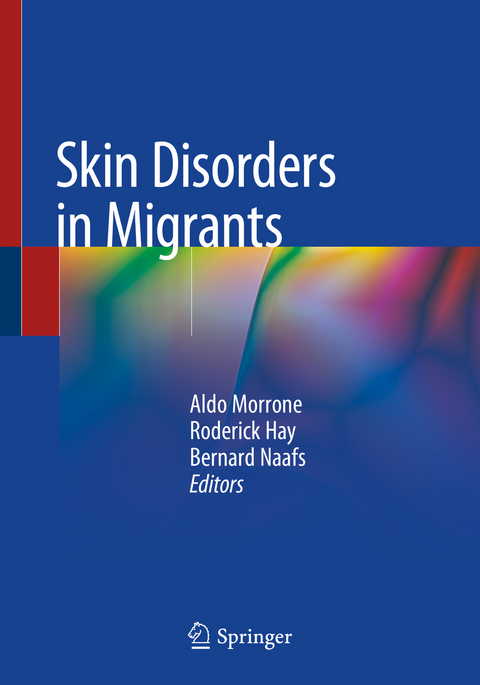
Skin Disorders in Migrants
Springer International Publishing (Verlag)
978-3-030-37478-5 (ISBN)
Professor Aldo Morrone is Scientific Director of San Gallicano Dermatological Institute IFO IRCCS. Previous positions include President of the MIH Foundation - the Mediterranean Institute of Hematology in Rome, Director of the Department of Preventive Medicine of Migration, Tourism, and Tropical Dermatology at the San Gallicano Dermatological Institute in Rome. Professor Morrone founded the National Institute for Migration and Poverty in Italy (NIMP) and is past General Director of the San Camillo-Forlanini Hospital in Rome. He is a Vice President of the International Society of Dermatology and founding Editor of the International Journal of Health, Culture and Migration. His main clinical and research interests today are linked to his role as President of the International Institute of Social, Medical, and Anthropological Sciences (IISMAS), a non-governmental organization that undertakes clinical and scientific projects aimed at benefiting people residing in the most disadvantaged areas of the world. He is the author of over 600 scientific papers in national and international journals and more than 50 books on Transcultural Medicine, Neglected Tropical Diseases, and Tropical Dermatology.
Professor Roderick James Hay, BA, BM BCh, MRCP, DM, MA, MRCPath, FRCP, FRCPath, FMed Sci, is Emeritus Professor of Cutaneous Infection at Kings College London and Consultant Dermatologist at The London Bridge Hospital. He is also Emeritus Professor at Queens University Belfast. Dr. Hay is the former Chairman of The International Foundation for Dermatology, and was a member of the Board of the International League of Dermatology Societies from 2001-2015. He is a member (for Dermatology) of the Global Burden of Disease Project and is a past President of the British Association of Dermatologists, the British Society for Medical Mycology, and the European Confederation of Medical Mycology. He is past Editor of Clinical and Experimental Dermatology and is section editor of Acta Dermatovenereologica (Infection). Dr. Hay is the recipient of many awards and honors.
Professor Bernard Naafs is consultant dermatologist for the Foundation Global Dermatology; visiting Professor at the Regional Dermatology Training Centre (RDTC), Kilimanjaro Christian Medical Centre, Tumaini University, Moshi, Tanzania; Invited Professor at the Instituto Lauro de Souza Lima (ILSL), Bauru, S.P., Brazil; visiting professor Department of Dermatology Ayder Referral Hospital University of Mekelle, Tigray, Ethiopia. He retired as Director of the Institute for Dermatology and Venereology "Polderma" Emmeloord/Steenwijk, the Netherlands. He has been Senior Consultant in Tropical Dermatology in the Department of Dermatology, Leiden University Medical Centre, the Netherlands; and Senior Lecturer in Dermatovenereology at the Royal Tropical Institute (KIT), Amsterdam, the Netherlands. Other previous appointments include Consultant Dermatologist, IJsselmeerziekenhuizen, Emmeloord/Lelystad, the Netherlands; Head of OPD Dermatology, Dijkzigt Hospital, Erasmus University, Rotterdam, the Netherlands; Head of Leprosy Control, Ministry of Health, Harare, Zimbabwe; Acting Head of Allergy and Immunodermatology, Department of Dermatovenereology, Binnengasthuis (later Academic Medical Centre), University of Amsterdam, the Netherlands; and Clinical Research Physician at the All Africa Leprosy and Rehabilitation Centre, Addis Ababa, Ethiopia. He received many rewards, among which the Eykman medal and was rewarded Knight of the Dutch Lion by Her Majesty Queen Beatrix of the Netherlands.
Chapter 1. What does it mean to be a migrant, asylum seeker or refugee - current global situation.- Chapter 2. Medical, Social and Civic Needs of Displaced Persons.- Chapter 3. Viral Dermatoses.- Chapter 4. Bacterial Dermatoses.- Chapter 5. Non-venereal Treponematoses.- Chapter 6. Fungal Infections.- Chapter 7. Protozoan Dermatoses.- Chapter 8. Helminthic Dermatoses.- Chapter 9. Dermatoses caused by arthropods.- Chapter 10. Eczema and Dermatitis.- Chapter 11. Maculo-papulo-squamous Dermatoses.- Chapter 12. Bullous Diseases.- Chapter 13. Connective Tissue Disorders.- Chapter 14. Urticaria and Drug-induced Eruptions.- Chapter 15. Hair, Nails and Sweat Glands Disorders.- Chapter 16. Benign Cutaneous Neoplasms.- Chapter 17. Malignant Cutaneous Neoplasms.- Chapter 18. Sexually transmitted infections and migration.- Chapter 19. Rare diseases including NTDs and their management.- Chapter 20. Abuse, self-harm, torture signs and PTSD.- Chapter 21. Female Genital Mutilation.- Chapter 22. Right and Agencies (Health).- Chapter 23. Access to Care and Facilities for Care.- Chapter 24. Understanding and Working with Traditional Beliefs, Cultures and Practices (Cupping, Coining, and other Ethno-dermatoses).- Chapter 25. What diseases occur where.- Chapter 26. Essential Medicines for Immediate Care in Refugee Camps.- Chapter 27. How to Recognize Skin Signs of Potentially Life-Threatening or Disabling Diseases (Malnutrition Driven Skin Disorders).
| Erscheinungsdatum | 12.04.2021 |
|---|---|
| Zusatzinfo | X, 245 p. 130 illus. in color. |
| Verlagsort | Cham |
| Sprache | englisch |
| Maße | 178 x 254 mm |
| Gewicht | 549 g |
| Themenwelt | Medizin / Pharmazie ► Medizinische Fachgebiete ► Dermatologie |
| Studium ► Querschnittsbereiche ► Infektiologie / Immunologie | |
| Studium ► Querschnittsbereiche ► Prävention / Gesundheitsförderung | |
| Schlagworte | Connective tissue disorders • Dermatologic diseases in refugees • Fungal, viral and bacterial infections • Genital mutilations • Genodermatoses • Infectious Diseases • neglected tropical diseases • Sexually Transmitted Diseases • Signs of torture • Skin neoplasms • Treponematoses |
| ISBN-10 | 3-030-37478-5 / 3030374785 |
| ISBN-13 | 978-3-030-37478-5 / 9783030374785 |
| Zustand | Neuware |
| Haben Sie eine Frage zum Produkt? |
aus dem Bereich


